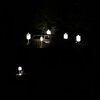Varminterror
Member
- Joined
- Jul 17, 2016
- Messages
- 14,857
Sorry (again) for a bit of a redirect from the current direction of the thread - but I wanted to dangle a particular carrot for folks thinking about getting into Precision Rifle competition.
“Lights Out” is going on this weekend in Oklahoma. It’s a suppressor only, night time precision rifle match. We started last night about 9pm, finishing up 10 stages around 3am this morning, and do it again tonight. No white lights, suppressed rifles only, targets out to 1088yrds, illuminated reticles and illuminated targets. Glow sticks, headlamps, invisible wind cues, unseen misses, and a ridiculous amount of fun!
My phone skope wouldn’t cooperate on all of my pictures, but you get the idea. Some of the backing berms were visible in the spotlights, but most of the targets are floating in the darkness.
I increased the exposure in the “starlight” photo below to add some detail - colored lights are my squad mates and rifles waiting on the field, laced with glow sticks so we don’t trip over stuff, while the white lights are the targets on the opposite ridgeline.





“Lights Out” is going on this weekend in Oklahoma. It’s a suppressor only, night time precision rifle match. We started last night about 9pm, finishing up 10 stages around 3am this morning, and do it again tonight. No white lights, suppressed rifles only, targets out to 1088yrds, illuminated reticles and illuminated targets. Glow sticks, headlamps, invisible wind cues, unseen misses, and a ridiculous amount of fun!
My phone skope wouldn’t cooperate on all of my pictures, but you get the idea. Some of the backing berms were visible in the spotlights, but most of the targets are floating in the darkness.
I increased the exposure in the “starlight” photo below to add some detail - colored lights are my squad mates and rifles waiting on the field, laced with glow sticks so we don’t trip over stuff, while the white lights are the targets on the opposite ridgeline.














